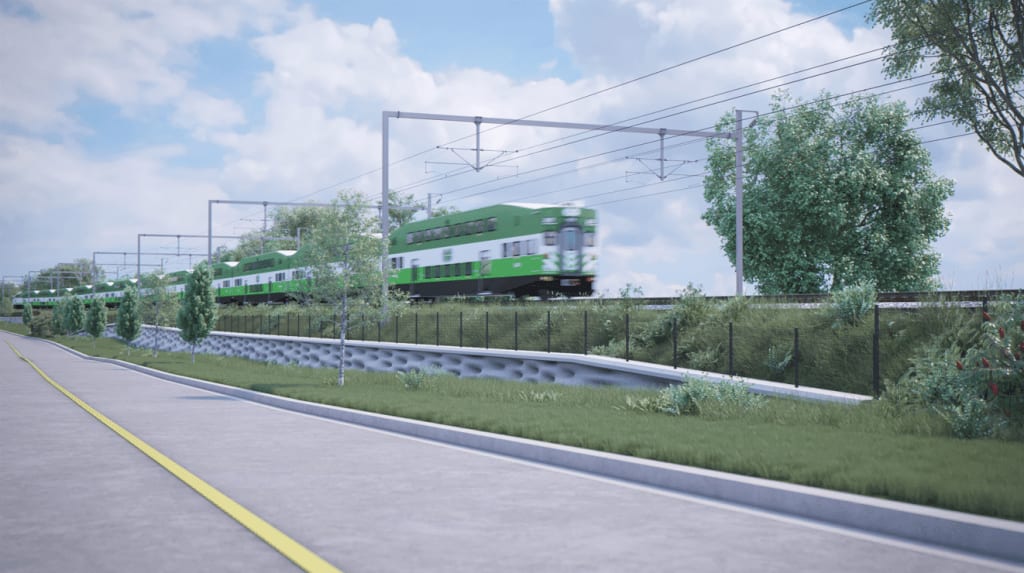How electric trains will improve GO Transit train trips
Electric trains will reduce trip times, improve customer experience, and help the environment.
Mar 15, 2022
Faster. Quieter. More frequent. No local emissions.
These are just a few of the many benefits that will be noticed by riders – and people living near the tracks and stations – as GO transitions to electric trains.
In this artist rendering, a GO train moves along a track, powered by electricity from above. (Metrolinx image)
When electricity-powered locomotives are added to the GO fleet, they will improve the transit experience in many ways, and the most obvious benefit for riders will be shorter travel times.
Electric trains are lighter and more powerful than the diesel ones we see today, allowing them to accelerate and decelerate faster with less cost.
This means they can maneuver in and out of stations faster. When you multiply this time saving by every station on your commute – and combine it with infrastructure upgrades that will allow trains to safely move at higher speeds – the result will be a shorter trip.
The lower cost of running these trains will also allow Metrolinx to more affordably expand services.
An electric powered GO train moves across a bridge, in this artist rendering. (Metrolinx image)
Customers will see shorter wait times between trains as GO works to increase rail capacity, tripling service to 6,000 trips per week, with trains moving every 15 minutes (or better) on core lines.
“We are going to be able to implement more rail services on the existing network,” said Menno Van Limburg, director for electrification on the Metrolinx Engineering & Asset Management team.
GO Expansion, is a massive project to electrify and upgrade GO rail service.
The plan includes adding infrastructure like overhead wires to deliver power to the electric trains, station improvements, new layovers, signal upgrades, additional track, and grade separations. The last three items in that list may not sound exciting, but they will keep trains moving and reduce travel times.
“Electrification, when combined with improvements to our signalling system, Union Station and track expansion will allow us to run more frequent services cost effectively,” said Naren Garg, the system integration program sponsor at Metrolinx.
Expanded service will contribute to a network effect that will encourage more people to use public transit.
“GO will have a high frequency service, like LRTs and subways, where you don’t have to look up when the next train is coming, because it’s usually only a few minutes away,” Van Limburg said.
This will add to the convenience of a train ride with much more predictable travel times than a car drive across the GTHA.
More trips also will mean more choice for riders.
“There will be different travel patterns – not just bringing commuters into downtown to work,” Van Limburg explained. “People will be travelling across the network and outside the city.”
The benefits will extend beyond riders to everyone living near the tracks.
Localized emissions will be vastly reduced as the electric trains will be powered by overhead wires instead of burning fossil fuels. Switching to electric trains will eliminate tail pipe emissions of particulate matter and nitrogen oxides, resulting in cleaner air.
Lighter, faster electric trains, coupled with infrastructure improvements that keep trains moving safely will reduce travel times. This is an artist’s rendering and it is subject to change. (Metrolinx image)
“Once we are able electrify as many of our lines as we can, there will certainly be a reduction in greenhouse gas emission,” said Mirjana Osojnicki, a Metrolinx manager in Environmental Programs and Assessment.
“The environment will also be improved by a domino effect when we are providing more frequent transit and giving people more reasons to leave their cars at home.”
Electric trains use less energy and they can even generate some of their own with regenerative (or dynamic) brake technology. While slowing down to a halt, the traction motors act as generators, converting the kinetic energy from braking into electricity.
This power can be used by other trains on the system, representing a 15 to 20 per cent saving in total energy.
Electric fleets are known to be more reliable than their diesel counterparts. After the initial capital outlay, they are less expensive to operate and maintain. They also last longer.
Currently, early works projects are underway to prepare the corridors for the installation of electrification infrastructure, ensuring that the wires and supporting apparatus can be safely installed and operated.
After reviewing many proposals, on Feb. 23, Metrolinx and Infrastructure Ontario announced that negotiations have begun – discussing plans to design, build and operate the system and chose the best fleet solution and service plan. This is the last stage before a contract can be signed.
“After talking about procurement, planning, and permitting we are now at the point where we are going to do this,” Van Limburg said.
To learn more about GO Expansion, please visit MetrolinxEngage.com.
by Mike Winterburn Metrolinx communications senior advisor
